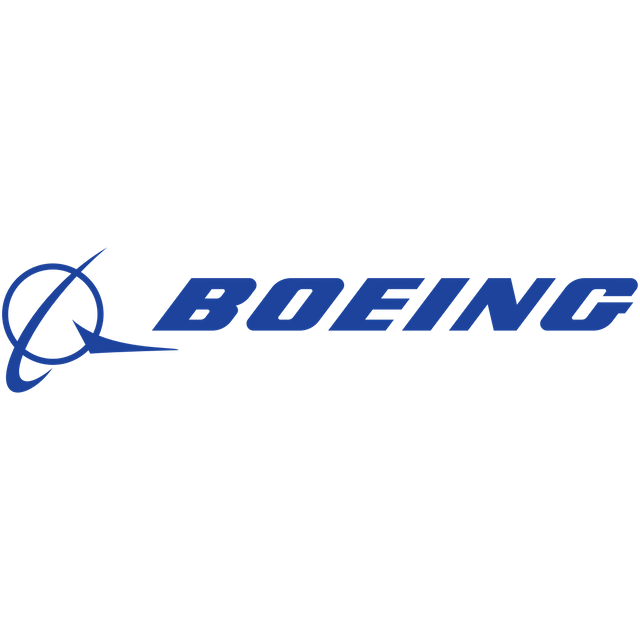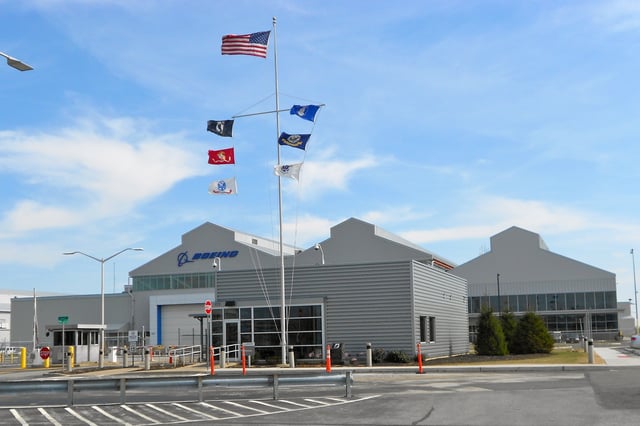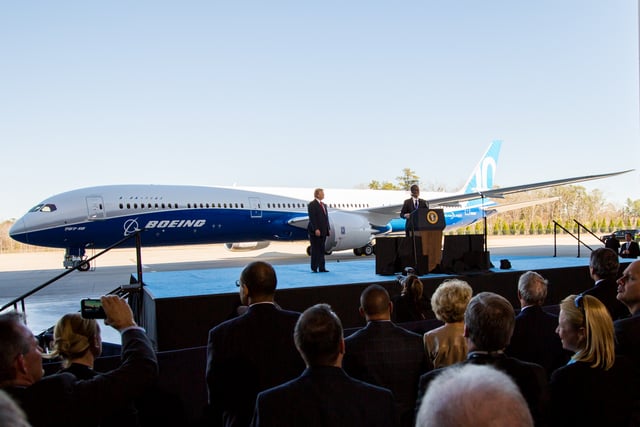Boeing

Boeing

 Boeing International Headquarters in Chicago | |
Formerly | Pacific Aero Products Co. (1916–1917) |
|---|---|
Type | Public |
| Traded as | |
| Industry |
|
| Founded | July 15, 1916 (1916-07-15)(as Pacific Aero Products Co.) Seattle, Washington, U.S. |
| Founder | William Boeing |
| Headquarters | Boeing International Headquarters, Chicago, Illinois ,U.S. |
Area served | Worldwide[1](p1) |
Key people | Dennis Muilenburg (Chairman, President & CEO) |
| Products | |
Production output |
|
| Services |
|
| Revenue | |
Operating income | |
Net income | |
| Total assets | |
| Total equity | |
Number of employees | 153,027 (January 1, 2018)[2] |
| Divisions |
|
| Subsidiaries |
|
| Website | www.boeing.com [75] |
| Footnotes / references [3] | |
The Boeing Company (/ˈboʊɪŋ/) is an American multinational corporation that designs, manufactures, and sells airplanes, rotorcraft, rockets, satellites, telecommunications equipment, and missiles worldwide. The company also provides leasing and product support services. Boeing is among the largest global aerospace manufacturers; it is the fifth-largest defense contractor in the world based on 2017 revenue,[4] and is the largest exporter in the United States by dollar value.[5] Boeing stock is included in the Dow Jones Industrial Average. Boeing is incorporated in Delaware.[6]
Boeing was founded by William Boeing on July 15, 1916, in Seattle, Washington.[7] The present corporation is the result of the merger of Boeing with McDonnell Douglas on August 1, 1997. Former Boeing chair and CEO Philip M. Condit continued as the chair and CEO of the new Boeing, while Harry Stonecipher, former CEO of McDonnell Douglas, became the president and chief operating officer of the newly merged company.[7]
The Boeing Company has its corporate headquarters in Chicago, Illinois. The company is led by President and CEO Dennis Muilenburg.[8][9][10] Boeing is organized into five primary divisions: Boeing Commercial Airplanes (BCA); Boeing Defense, Space & Security (BDS); Engineering, Operations & Technology; Boeing Capital; and Boeing Shared Services Group. In 2017, Boeing recorded US$93.3 billion in sales, ranked 24th on the Fortune magazine "Fortune 500" list (2018),[11] ranked 64th on the "Fortune Global 500" list (2018),[12] and ranked 19th on the "World's Most Admired Companies" list (2018).[13]
 Boeing International Headquarters in Chicago | |
Formerly | Pacific Aero Products Co. (1916–1917) |
|---|---|
Type | Public |
| Traded as | |
| Industry |
|
| Founded | July 15, 1916 (1916-07-15)(as Pacific Aero Products Co.) Seattle, Washington, U.S. |
| Founder | William Boeing |
| Headquarters | Boeing International Headquarters, Chicago, Illinois ,U.S. |
Area served | Worldwide[1](p1) |
Key people | Dennis Muilenburg (Chairman, President & CEO) |
| Products | |
Production output |
|
| Services |
|
| Revenue | |
Operating income | |
Net income | |
| Total assets | |
| Total equity | |
Number of employees | 153,027 (January 1, 2018)[2] |
| Divisions |
|
| Subsidiaries |
|
| Website | www.boeing.com [75] |
| Footnotes / references [3] | |
History
The Boeing Company was started in 1916 when American timber salesperson William E. Boeing founded Aero Products Company. Shortly before doing so, he and Conrad Westervelt created the "B&W" seaplane. In 1917, the organization was renamed Boeing Airplane Company, with William Boeing forming Boeing Airplane & Transport Corporation in 1928. In 1929, the company was renamed United Aircraft and Transport Corporation, followed by the acquisition of several aircraft makers such as Avion, Chance Vought, Sikorsky Aviation, Stearman Aircraft, Pratt & Whitney, and Hamilton Metalplane.[14]
In 1931, the group merged its four smaller airlines into United Airlines. In 1934, the manufacture of aircraft was required to be separate from air transportation. Therefore, Boeing Airplane Company became one of three organizations to arise from dissolution of United Aircraft and Transport; the other two groups were United Aircraft Corporation (now United Technologies Corporation) and United Airlines.[14]
In 1960, the company bought Vertol Corporation, which at the time, was the biggest independent fabricator of helicopters. During the 1960s and 1970s, the company diversified into industries such as outer space travel, marine craft, agriculture, energy production and transit systems.[14]
In 1995, Boeing partnered with Russian, Ukrainian and Anglo-Norwegian organizations to create Sea Launch, a company providing commercial launch services sending satellites to geostationary orbit from floating platforms, and five years later, acquired the satellite segment of Hughes Electronics.[14]
Divisions

Boeing plant in Ridley Park, Pennsylvania
The corporation's three main divisions are Boeing Commercial Airplanes (BCA), Boeing Defense, Space & Security (BDS), and Boeing Global Services.[17]
Boeing Commercial Airplanes (BCA)
Boeing Defense, Space & Security (BDS) Phantom Works
Boeing Global Services
Boeing Capital
Engineering, Test & Technology
Boeing Shared Services Group
Boeing NeXt - explores urban air mobility
Environmental record
In 2006, the UCLA Center for Environmental Risk Reduction released a study showing that Boeing's Santa Susana Field Laboratory, a site that was a former Rocketdyne test and development site in the Simi Hills of eastern Ventura County in Southern California, had been contaminated by Rocketdyne with toxic and radioactive waste. The study found that air, soil, groundwater, and surface water at the site all contained radionuclides, toxic metals, and dioxins; air and water additionally contained perchlorate, TCE, and hydrazines, while water showed the presence of PCBs as well.[18] Clean up studies and lawsuits are in progress.[19][20]
Jet biofuels
The airline industry is responsible for about 11% of greenhouse gases emitted by the U.S. transportation sector.[21] Aviation's share of the greenhouse gas emissions is poised to grow, as air travel increases and ground vehicles use more alternative fuels like ethanol and biodiesel.[21] Boeing estimates that biofuels could reduce flight-related greenhouse-gas emissions by 60 to 80%.[21] The solution blends algae fuels with existing jet fuel.[21]
Boeing executives said the company is informally collaborating with Brazilian biofuels maker Tecbio, Aquaflow Bionomic of New Zealand and other fuel developers around the world. So far, Boeing has tested six fuels from these companies, and will probably have gone through twenty fuels "by the time we're done evaluating them".[21] Boeing was also joining other aviation-related members in the Algal Biomass Organization (ABO) on June 2008.[22]
Air New Zealand and Boeing are researching the jatropha plant to see if it is a sustainable alternative to conventional fuel.[23] A two-hour test flight using a 50–50 mixture of the new biofuel with Jet A-1 in a Rolls Royce RB-211 engine of a 747-400 was completed on December 30, 2008. The engine was then removed to be studied to identify any differences between the Jatropha blend and regular Jet A1. No effects on performances were found.
On August 31, 2010, Boeing worked with the U.S. Air Force to test the Boeing C-17 running on 50% JP-8, 25% Hydro-treated Renewable Jet fuel and 25% of a Fischer–Tropsch fuel with successful results.[24]
Electric propulsion
For NASA's N+3 future airliner program, Boeing has determined that hybrid electric engine technology is by far the best choice for its subsonic design. Hybrid electric propulsion has the potential to shorten takeoff distance and reduce noise.[25]
Political contributions, federal contracts, advocacy

Boeing CEO Dennis Muilenburg and President Trump at the 787-10 Dreamliner rollout ceremony
In both 2008 and 2009, Boeing was second on the list of Top 100 US Federal Contractors, with contracts totaling US$22 billion and US$23 billion respectively.[26][27] Since 1995, the company has agreed to pay US$1.6 billion to settle 39 instances of misconduct, including US$615 million in 2006 in relation to illegal hiring of government officials and improper use of proprietary information.[28][29]
Boeing secured the highest ever tax breaks at the state level in 2013.[30]
Boeing's spent US$16.9 million on lobbying expenditures in 2009.[31][32] In the 2008 presidential election, Barack Obama "was by far the biggest recipient of campaign contributions from Boeing employees and executives, hauling in US$197,000 – five times as much as John McCain, and more than the top eight Republicans combined".[33]
Boeing has a corporate citizenship program centered on charitable contributions in five areas: education, health, human services, environment, the arts, culture, and civic engagement.[34] In 2011, Boeing spent US$147.3 million in these areas through charitable grants and business sponsorships.[35] In February 2012, Boeing Global Corporate Citizenship partnered with the Insight Labs to develop a new model for foundations to more effectively lead the sectors they serve.[36]
The company is a member of the U.S. Global Leadership Coalition, a Washington D.C.-based coalition of more than 400 major companies and NGOs that advocate a larger International Affairs Budget, which funds American diplomatic and development efforts abroad.[37] A series of U.S. diplomatic cables show how U.S. diplomats and senior politicians intervene on behalf of Boeing to help boost the company's sales.[38]
In 2007 and 2008, the company benefited from over US$10 billion of long-term loan guarantees, helping finance the purchase of their commercial aircraft in countries including Brazil, Canada, Ireland and the United Arab Emirates, from the Export-Import Bank of the United States, some 65% of the total loan guarantees the bank made in the period.[39]
In December 2011, the non-partisan organization Public Campaign criticized Boeing for spending US$52.29 million on lobbying and not paying taxes during 2008–2010, instead getting US$178 million in tax rebates, despite making a profit of US$9.7 billion, laying off 14,862 workers since 2008, and increasing executive pay by 31% to US$41.9 million in 2010 for its top five executives.[40]
Financial numbers
For the fiscal year 2017, Boeing reported earnings of US$8.191 billion, with an annual revenue of US$93.392 billion, a 1.25% decline over the previous fiscal cycle. Boeing's shares traded at over $209 per share, and its market capitalization was valued at over US$206.6 billion.[41]
| Year | Revenue in million US$ | Net income in mil. US$ | Price per Share in US$ | Employees |
|---|---|---|---|---|
| 2005 | 53,621 | 2,572 | 45.42 | |
| 2006 | 61,530 | 2,215 | 59.20 | |
| 2007 | 66,387 | 4,074 | 71.05 | |
| 2008 | 60,909 | 2,672 | 50.76 | |
| 2009 | 68,281[42] | 1,312 | 35.73 | |
| 2010 | 64,306[43] | 3,298 | 53.89 | |
| 2011 | 68,735[44] | 4,009 | 58.20 | |
| 2012 | 81,698[45] | 3,900 | 62.65 | |
| 2013 | 86,623[46] | 4,578 | 90.39 | 168,400 |
| 2014 | 90,762[47] | 5,440 | 114.72 | 165,500 |
| 2015 | 96,114[48] | 5,172 | 131.43 | 161,400 |
| 2016 | 94,571[49] | 4,892 | 125.66 | 150,500 |
| 2017 | 93,392[50] | 8,191 | 209.85 | 140,800 |
| 2018 | 101,127[51] | 10,460 | 319.05 | 153,000 |
Between 2010 and 2018, Boeing increased its operating cash flow from $3 to $15.3 billion, sustaining its share price, by negotiating advance payments from customers and delaying payments to its suppliers. This strategy is sustainable only as long as orders are good and delivery rates are increasing.[52]
From 2013 to 2019, Boeing spent over $60 billion on dividends and stock buybacks, twice as much as the development costs of the 787.[53]
Employment numbers
The company's employment count is listed on its website below.
|
|
Corporate governance
Board of directors
Chief executive officer
| Chairman of the board
President
|
See also
Airbus
Boeing Renton Factory
Comac
United Aircraft Corporation
Competition between Airbus and Boeing
Future of Flight Aviation Center & Boeing Tour – Corporate public museum
United States Air Force Plant 42
Boeing 737 MAX groundings